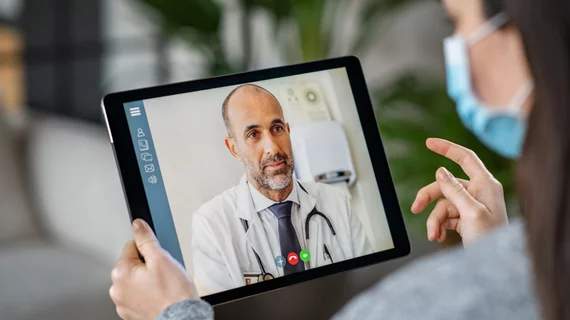Telehealth visits key to maintaining interventional radiology exam volumes, revenue during pandemic
Telehealth consultations helped one large health system maintain its interventional radiology exam volumes and revenue early in the pandemic when in-person visits were prohibited, according to new research. It may be a go-to strategy for future uncertainties.
Physicians with Mount Sinai Hospital in New York set out to assess telemedicine’s impact on IR evaluation and management encounters between Jan. 6 and Aug. 23, sharing their findings Tuesday.
During the COVID-19 surge period, when Sinai paused elective surgery and imaging, outpatient E&M visits dropped by more than 55%, with telemed consults accounting for 44% of the remaining total during that time period spanning March 16 to June 7.
E&M figures bounced back to 2019 levels by the end of Sinai’s recovery phase and, with virtual consults included, nearly doubled last year’s totals, amounting to a 93.3% increase, the authors explained.
“Historically, E&M has been an important contribution to the overall IR revenue, however, during a pandemic E&M assumes greater significance as an additional source of revenue,” Daryl Goldman, MD, with Sinai’s Department of Diagnostic, Molecular, and Interventional Radiology, and colleagues added. “Telehealth is a means to maintain a revenue stream from E&M when procedures are prohibited and face-to-face visits are discouraged.”
Importantly, the U.S. Centers for Medicare & Medicaid Services recently unveiled its 2021 Medicare Physician Fee Schedule, which includes radiology payment cuts due to E&M coding changes, including an estimated 8% decrease for interventional rads. Industry advocates have pushed back and urged Congress to intervene. On recent effort includes a new Senate bill endorsed by nearly 80 medical societies, including the ACR and Society of Interventional Radiology.
For their current investigation, Goldman et al. retrospectively reviewed interventional E&M encounters by analyzing weekly current procedure technology codes from each IR division. They divided the data into three COVID-19 waves using 2019 as a historical reference: pre-surge (Jan. 6-March 15); surge (March 16-June 7); and recovery (June 8-Aug. 23).
Sinai’s IR department didn’t offer telemed visits before the pandemic hit and during the study, such consults accounted for 22.8 mean weekly encounters, with volume peaking at 34 visits during the week of May 11.
In-person E&M visits gradually increased during the system’s recovery phase, but still, volumes dropped by 50% overall, similar to figures reported in prior studies. And during the final week of their investigation, telemedicine comprised 11.5% of outpatient volumes.
The researchers said they had difficulties implementing a HIPAA-compliant platform and ensuring patients had access to computers. Phone visits were more often used to overcome these challenges, with video consultations reserved for special cases.
Nevertheless, their journey should serve as a blueprint of sorts for other IR departments, the authors noted.
“Because local effects of the COVID-19 pandemic are difficult to predict, planning for additional outbreaks should include capacity to scale telehealth in the event of renewed restrictions on elective procedures,” they added. “The results described in this study can provide IR departments across the country information for preparation, budgeting, and resource allocation during similar transition periods.”
Read the entire pre-proof article in the Journal of Vascular and Interventional Radiology here.

